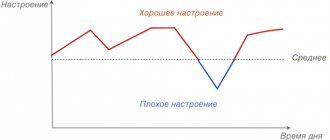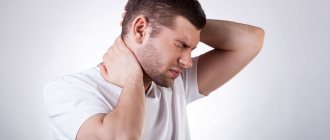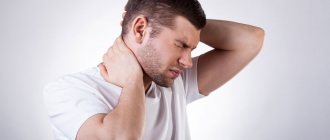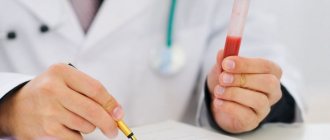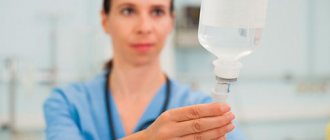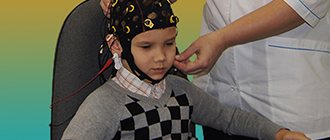Migraine is a type of headache characterized by repeated intense attacks. In addition, migraine is accompanied by a combination of various neurological, autonomic and gastrointestinal symptoms. According to statistics, the disease ranks 6th among diseases leading to a decrease in quality of life.
Migraine attacks are most often diagnosed in women. The onset of the disease occurs at the age of 10-20 years. The maximum number of attacks is reached by 30-45 years.
What does migraine with aura mean?
Migraine with aura is a disorder characterized by recurrent episodes of reversible local neurological symptoms (aura), usually increasing over 5-20 minutes and lasting no more than 60 minutes.
“Aura” is a term by which doctors mean the following:
- Visual impairment
. These can be lines, lights, spots, flickering. In severe cases, loss of vision. All manifestations are reversible. - Sensory perception disorders
. It seems that goosebumps are crawling all over the body, the person feels tingling, and there may be areas of numbness. All this is also reversible. - Speech disorders
, which also go away along with the attack.
In 73% of migraine attacks with aura, the headache begins not after the end of the aura, but during the aura itself and can be accompanied by other migraine symptoms - nausea (51%), photophobia (88%) and phonophobia (73%) i Morozova O.G. Migraine: new international criteria for diagnosis and principles of therapy based on evidence-based medicine and our own clinical experience / O.G. Morozova // International Neurological Journal. — 2021. — No. 3 (81). — pp. 131-138. . It happens that a panic migraine develops. Its complications are fear, anxiety, etc.
Migraines with and without aura are the same. A person usually feels a throbbing pain in one side of the head. Often it is concentrated in the eyeball. The pain intensifies with movement, sound and light stimuli. It can last from 4 hours to 3 days. At this time, it is impossible to lead a normal lifestyle. A person wants to be left alone in a dark and cool room, freeze, hide under the blanket. Typically, patients describe the pain as “bursting,” “splitting,” “about to burst,” “every sound like a hammer on the head.” And even after an attack, the consequences persist. The person is apathetic, tired and overwhelmed. It takes more than one day to recover.
Treatment
If a patient is diagnosed with migraine, the doctor selects treatment taking into account many factors, including examination results:
- Drug therapy is symptomatic. The main goal of drug therapy is to reduce the intensity of attacks. The doctor selects tablets for migraine taking into account the form of the disease, the patient’s health condition and the nature of the attacks;
- for minor pain, non-steroidal anti-inflammatory drugs can be prescribed;
- for infrequent attacks and mild forms of the disease, anilades in combination with the effect of vasoconstriction are effective against migraines;
- triptans for migraines with a vasoconstrictor effect.
It is important to remember that migraine medications are selected for the patient and prescribed only by a doctor, since uncontrolled use of medications can cause side effects and complications that will lead to serious deterioration in health.
Non-drug methods include organizing a work and rest schedule, eliminating foods that stimulate attacks, giving up alcohol and smoking, selecting a diet, etc.
Among non-drug methods, mention should be made:
- neck massage;
- acupuncture;
- acupressure.
Specialists at the Pain Treatment Center of JSC “Medicine” (academician Roitberg’s clinic) approach the treatment of migraines in a comprehensive manner. An integrated approach allows us to minimize the impact of the disease on the patient’s body and the patient’s health as a whole. The combination of various methods of rehabilitation and therapy allows you to achieve excellent results in a short time. Contacting the neurologists of JSC "Medicine" (clinic of Academician Roitberg) provides the opportunity to significantly improve the quality of life.
Differences from migraine without aura
Migraine without aura is called “classic”. Approximately 80% of patients suffer from it. A migraine without an aura manifests itself as throbbing pain at one point. It is not preceded by any visual, auditory or sensory impairment. Sometimes people don’t even realize that it’s a migraine, but think that they just have a headache. For this reason, patients do not go to the doctor, which is fraught with consequences.
You have migraine without aura if the following symptoms are present:
- 5 episodes of pain.
- The attacks last from 4 to 72 hours if you do not take medication.
- The pain throbs and is concentrated on one side of the head. The forehead, neck, and then the face or back of the head may hurt.
- With any physical activity the pain gets worse.
- There may be nausea, fear of light, sounds, voices.
Home remedies
Home remedies for migraines can complement the effects of drug therapy. If migraine is diagnosed, treatment at home can be undertaken after consultation with a doctor. Among the most effective methods it should be noted:
- infusions of medicinal herbs (chamomile, peppermint, lavender, raspberry leaves, etc.);
- infusion of oregano as a preventative measure;
- mumiyo solution before bedtime;
- rubbing essential oils into temples for mild attacks;
- cold compresses on the head;
- rest in a darkened room with clean air in silence.
What are the characteristics of migraine with aura?
About 20% of patients experience an aura. But only a few say that it occurs with every attack. The most common symptom of an aura is visual disturbances. Less commonly – sensory organ disorders (tingling, numbness, goosebumps). Aura symptoms are divided into positive and negative. In the first case, something is felt, and in the second, the fields of vision disappear or the hands go numb. Another property of the aura is dynamism. That is, a gradual increase in symptoms, and then their gradual decline. Usually the aura is replaced by a headache, but sometimes the aura appears on its own.
Migraine with aura is characterized by the following symptoms:
- Two episodes of migraine without aura.
- The presence of an aura for 1 hour or more before pain occurs. In this case, the following neurological symptoms appear - one or more:
- visual disturbances – photophobia, blinking, black spots in the field of vision, flickering arches, lines, zigzags, incorrect perception of objects in the field of vision;
- sound disorders, mainly intolerance to any sounds;
- speech problems;
- sensory disturbances – tingling, burning, numbness, etc.;
- impairment of motor abilities, such as sudden weakening of muscles on one side of the body.
Migraine stages
Migraine attacks occur in several stages. Among them:
- Prodrome. In other words, harbingers of headaches. The occurrence of these symptoms is observed in 50% of patients suffering from migraine. Pathological signs include irritability, emotional lability, weakness, thirst, swelling, muscle tension in the neck and back of the head. These symptoms may occur several hours or days before the attack.
- Migraine aura. This is a set of neurological symptoms that occur immediately before a migraine attack. In accordance with this, violations are distinguished:
- visual (flashes or colored lines, loss of areas of vision;
- motor;
- sensitive (numbness, tingling);
- speech.
The intensity of the listed migraine symptoms gradually increases. The duration of a migraine aura can be 1 hour.
- Stage of headache. Signs of a migraine are an intense headache that appears on one side (less often bilateral). Its severity increases even with moderate physical activity. A migraine attack is accompanied by nausea, vomiting, and increased sensitivity to light and sounds. The duration of headache without appropriate therapy can reach 3 days.
- Postdrome. The stage that occurs after the headache has subsided. Symptoms of postdrome include pale skin, yawning, irritability, and fatigue. These symptoms of migraine may persist for 2 days.
Causes of migraine
The mechanisms of migraine development are not fully understood. A predisposing factor in the development of the disease is hereditarily determined dysfunction of vasomotor regulation. Approximately 70% of migraine patients have close relatives with a history of migraine-like headaches i Morozova O.G. Migraine: modern ideas about classification, diagnosis, therapy and prevention (part I) / O.G. Morozova // Emergency Medicine. - 2012. - No. 4 (43). — P. 32-41. .
There are two groups of factors that influence the course of migraine: those that worsen the course of migraine as a whole and those that provoke an attack.
Factors that worsen the course of migraine . In a patient with migraine, factors such as emotional stress, frequent consumption of alcoholic beverages, and other environmental influences can cause a long-term (over several months or years) worsening of the disease in the form of an increase in the frequency and/or intensity of attacks.
In patients with migraine, precipitating factors increase the likelihood of attacks; their effects usually appear within less than 48 hours. Despite the fact that migraine triggers have been well studied in a number of epidemiological studies (for example, the influence of menstruation i Koreshkina M.I. Modern aspects of diagnosis and treatment of migraine / M.I. Koreshkina // Neurology, neuropsychiatry, psychosomatics. - 2013. - P. 92-96.) and clinical (the effect of aspartame, chocolate, etc.) studies, in each individual case it is not always easy to establish a direct causal relationship between the provocateur and a migraine attack.
Factors provoking migraine paroxysms (migraine triggers) i Morozova O.G. Migraine: modern ideas about classification, diagnosis, therapy and prevention (part I) / O.G. Morozova // Emergency Medicine. - 2012. - No. 4 (43). — P. 32-41. :
- dietary: hunger, irregular nutrition, some foods (chocolate, cheese, nuts, alcohol (red wine), creams, yogurt, chicken liver, avocado, citrus fruits, bananas, concentrated soups, fried pork, sausages, pizza, coffee, cola, tea);
- hormonal: menstruation, ovulation, estrogen replacement therapy, oral contraceptives;
- psychological: emotional stress, anxiety,
- depression, fatigue;
- weather changes;
- exercise stress;
- lack or excess of night sleep;
- stuffiness, odors (smell of perfume);
- visual stimuli (flickering or bright light);
- cold;
- noise;
- staying on top.
Causes
The reasons why hemicrania appears are still not fully understood. During the research, scientists determined the fact that predisposition to this disease is inherited. The disease, namely the characteristics of the nervous system, is transmitted by women who suffer from hemicrania much more often than men.
The main cause of attacks is said to be activation of the trigeminal nucleus, which alternately leads to spasm and subsequent dilation of the arteries of the brain. It has also been determined that a failure of seratonin metabolism in the central nervous system is involved in the formation of pain.
Predisposition appears when exposed to triggers or certain factors, which doctors have divided into 4 groups:
- psychological triggers, including stress, emotional and mental stress;
- external triggers, the list of which includes changes in atmospheric pressure, loud sounds, bright lighting, odors, stuffy atmosphere, etc.;
- physiological triggers, which include fatigue, insomnia, hormonal imbalances;
- food triggers. Doctors call alcohol and tyramine contained in many foods (citrus fruits, smoked meats, cocoa, cheese, nuts, chocolate, etc.) the main stimulants of hemicrania attacks.
An attack can also be caused by insufficient consumption of clean water and food, diet or caffeine withdrawal, traveling with a change in time zones, weather changes, menstrual cycles in women, relaxation after severe stress. Migraines can occur in men and women due to hormonal imbalances due to external factors, as well as due to prolonged abstinence during sexual activity.
Types and symptoms of migraine auras
Let's look at the main types of auras and how they manifest themselves.
Visual or ophthalmological
This aura is called “classical”. With it, visual images appear - flashes of light, curved or straight lines, flickering objects, white or golden figures, spherical images, etc.
Symptoms develop over 5-30 minutes. Positive ones can be replaced by negative ones. The duration of the aura can reach 1 hour. The image usually appears in the center of the visual field. It gradually increases and moves to the periphery. A scotoma remains behind him
– dark, “blind” area. During the aura or within an hour after its appearance, pain occurs. When the attack ends, any disturbances go away without consequences.
Retinal
With such an aura, scotomas or blindness in one eye occur. Symptoms persist for up to 1 hour. The headache comes after scotomas in about an hour, but can also occur before them. This is a rare type of aura. There is an assumption that the symptoms appear due to spasm of the central retinal artery. In most patients, retinal migraine attacks alternate with migraine attacks with or without classic aura.
Auditory
Auditory auras are hallucinations with sound. Ringing in the ears may occur, and patients sometimes hear music or voices. Doctors associate this aura with epileptic activity in the cerebral cortex, in its temporal region.
Speech
It manifests itself as a speech disorder because it affects the speech centers of the brain. Before an attack of pain, for a few minutes, no more, it is difficult or impossible for a person to speak. He can rearrange syllables in words, letters, repeat the same thing. At the same time, the consciousness is absolutely pure.
Vestibular
This is an aura in the form of movement disorders - dizziness. A fairly common phenomenon that can be hidden or obvious. In the second case, a person “sicks” even with small loads. In the first, violations can only be detected within the framework of an examination. According to the ICD, 2 forms of vestibular migraine are distinguished:
- Basilar
- occurs rarely, mainly in teenage girls. The attack begins with visual disturbances, followed by dizziness, tinnitus, sensory disturbances, etc. Then, in 25% of cases, confusion occurs. Neurological symptoms persist for 20-30 minutes, then pain in the back of the head occurs. Without treatment, throbbing pain may persist for 2-3 days. - Paroxysmal dizziness of younger children
(benign). Occurs in children 1-4 years old. It manifests itself as short – from a few seconds to a few minutes – attacks of dizziness. The child loses stability, becomes anxious, and vomits. He may turn pale and sweat profusely. No headache. Attacks may recur over several months or years.
Vegetative
Often such auras are manifested by a feeling of heat, chills, cold, trembling; the face and neck may turn red or pale. Goosebumps may appear, and hairs may even rise on the skin. During an attack, the size of the pupil may change, and asymmetrically. Usually such an attack is part of a complex attack, and not an independent phenomenon.
Migraine treatment
The main goal of treatment for migraine attacks is to alleviate the course of the disease, improve the quality of life and reduce the risk of chronicity of the disease. Treatment includes:
- relief of acute pain syndrome;
- relapse prevention.
Treatment of acute migraine attacks
The following drugs are used to relieve pain:
- Nonsteroidal anti-inflammatory drugs (ibuprofen, ketorolac, diclofenac, acetylsalicylic acid, paracetamol). It is important to remember about the possibility of developing an overuse headache. It occurs due to excessive use of painkillers.
- Antiemetics. Prescribed due to the presence of severe atony of the stomach and intestines, which accompanies migraine. Antiemetic drugs stimulate intestinal motility and normalize absorption.
- Triptans. They are the “gold standard” of migraine therapy. The drugs block the release of pain neuropeptides. The effect occurs 20-30 minutes after ingestion.
It is recommended to start therapeutic measures as early as possible. It is advisable to take the drug within the first 30 minutes after the onset of the attack. Therapy is selected individually by the attending physician.
Diagnosis of migraine with aura
The diagnosis is made by a neurologist, and it is he who should be contacted with such a problem as soon as possible. The doctor must rule out cysts, tumors, encephalitis and vascular pathologies that cause similar symptoms. Therefore, a neurological examination, CT or MRI of the brain is performed, and the patient is sent for a consultation with an ophthalmologist for examination and determination of visual fields.
An EEG (electroencephalography) is required, which provides information about the functional activity and characteristics of the brain biorhythm of a particular patient. Based on the EEG results, the doctor then selects medications for therapy.
Diagnostics
Diagnosis of migraine is carried out on the basis of collecting complaints and anamnesis of patients, examining the patient and talking with him. If the initial consultation does not allow you to accurately diagnose the disease or identify the causes of the pathology, the neurologist can give a referral for an extensive examination using modern diagnostic equipment:
- MRI of the neck and brain;
- CT scan of the brain;
- brain scinography;
- electroencephalography;
- duplex scanning of arteries;
- Doppler ultrasound.
Consultation with an ophthalmologist allows you to determine the condition of the fundus and cerebral vessels. The presence of migraine symptoms may indicate serious pathologies, so a thorough examination is mandatory. JSC "Medicine" (academician Roitberg's clinic) is equipped with the latest diagnostic equipment, allowing examination of any complexity. The clinic is located in the center of Moscow at 2nd Tverskoy-Yamskaya lane, 10, a five-minute walk from the Mayakovskaya metro station.
Migraine is often a symptom of more severe diseases, so high-quality diagnosis using modern diagnostic equipment is an effective way to timely detect pathologies. Timely detection of diseases and contacting qualified doctors is a prerequisite for recovery and full restoration of vital activity.
JSC "Medicine" (clinic of academician Roitberg) is a multidisciplinary center, which provides patients with the opportunity to easily consult with specialists in various fields of medicine.
Features of migraine manifestations in children and pregnant women
In childhood, the peculiarity of an attack is its short duration, from 30 minutes to several hours, and bilateral pain. It becomes one-sided in adolescence. Most often, children experience pain in the temples, forehead, and periorbital area. The nature of the pain is also not the same as in adults. The pain is squeezing, pounding, slightly throbbing. Children describe the latter extremely rarely.
It is difficult for a child to talk about his feelings, so the intensity of pain is assessed using VAS - a visual analogue scale with points from 0 to 10. Scales with emoticons can be used - from smiling to crying.
During pregnancy, migraines can occur even in those who have not previously suffered from them. In 25% of cases it is migraine with aura. It is much more difficult to tolerate, and there is almost nothing to eliminate the pain due to the delicate position. The approved drugs - No-Shpa, Citramon or Paracetamol - do not help. During pregnancy, aura most often manifests itself as photophobia, withdrawal, intolerance to sounds and strong odors, very severe nausea and the urge to vomit. The main causes of pain during pregnancy:
- consumption of “dangerous” foods – cheese, chocolate, citrus fruits;
- lack of water in the body;
- constant lack of sleep because the stomach makes it very uncomfortable to sleep;
- stress, frequent worries;
- large weight gain;
- violation of metabolic processes.
Hemicrania in women
Migraine is diagnosed, the symptoms of which in women depend on the cause much more often than in men. Among the main causes of attacks in women:
- changes in vascular tone under the influence of hormonal levels changing throughout the menstrual cycle. For some women, migraine pain occurs during bleeding, for others during ovulation. Migraine medication is prescribed taking into account the patient’s hormonal background and her age;
- pregnancy, during which the load on the pregnant woman’s circulatory system increases significantly. Treatment of migraine in pregnant women requires caution when choosing medications;
- menopause, with the onset of which the ratio of hormones in a woman’s body changes significantly.
Since migraine, the symptoms and treatment of which in women depend on the individual characteristics of the body, can appear unexpectedly, doctors recommend taking preventive measures. Prevention using traditional medicine, massage and other types of therapeutic effects can significantly reduce the risk of an attack.
How to treat migraine with aura and how to relieve pain effectively and quickly
Since it is almost impossible to avoid an attack if there is a trigger, you need to know ways to improve the condition, because migraine is not a death sentence.
The final diagnosis is made by a neurologist. He will tell you what to do, how to treat the disease, how to increase the intervals between attacks.
Treatment for migraines is based on eliminating the pain and making it happen as little as possible or go away altogether. NSAIDs or specific medications, most often triptans, may be used. Intravenous infusion therapy is also used to treat migraines. The effectiveness of pain relief is directly proportional to the time of taking the drugs. You can stop an attack when it has just begun. Unfortunately, many people miss this moment with the thought “what if it doesn’t hurt.” However, at the peak of an attack, the tablets have almost no effect, because with migraine gastrostasis in the intestines, the absorption of any substances is very difficult.
Alternative ways to alleviate the condition are physical activity, exercise therapy, physiotherapy, and psychotherapy. Massage of the collar area is especially useful, because muscle spasm in this area can provoke an attack. Recently, migraines have been successfully treated with injections of botulinum toxin type A. The injections make remission last longer, and in some cases relieve pain for a very long time.
Treatment of migraines using traditional medicine
Many traditional medicine methods can provide relief from pain.
Ginger root
Ginger has the ability to block prostaglandins, thereby reducing the severity of pain. The same principle applies to most NSPVs. Ginger tea is prepared at home. Ginger root is crushed, then added to boiling water and simmered for 10 minutes over low heat. Next, the tea is filtered and drunk plain or with lemon and honey.
Chamomile
Has an anti-inflammatory and calming effect. You need to take two tablespoons of chamomile in a glass of water and cook the mixture for 5 minutes over low heat. Next, you need to strain the broth and drink it plain or with lemon and honey.
Lavender
Lavender oil is used for inhalation. The solution is prepared as follows: a teaspoon of oil is diluted in three glasses of boiling water. Breathe over the resulting solution for 15 minutes. Lavender oil can be mixed with peppermint oil and apply the mixture to the temples, gently massaging it a little. It is best to combine massage and inhalation.
Non-drug methods of prevention
A migraine attack can be prevented not only with the help of medications. Cognitive behavioral therapy can reduce stress levels and correct pain syndrome. Through sessions with a doctor, patients are able to learn psychological and muscle relaxation techniques. Cognitive-behavioral therapy is indicated for persons with signs of emotional-personal and hypochondriacal disorders. In severe cases, observation by a psychiatrist is necessary.
Neck massage, acupuncture, therapeutic exercises and manual therapy have a positive effect. In the absence of effect from drugs, the use of various instrumental methods is indicated. Among them are stimulation of the occipital, vagus and supraorbital nerves.
What happens if migraine is left untreated?
Migraine is not a harmless disease. The disease is identified by the World Health Organization as a risk factor for cerebral strokes. Numerous epidemiological studies have revealed correlations between migraine and stroke, especially in young women suffering from migraine with aura i Ashina M. Vascular changes have a primary role im migraine / M. Ashina // Cephalalgia. - 2012. - 32. - 5. - P. 428-430. . Migraine is associated with a 16-fold increase in the risk of stroke in pregnancy and the overall risk of cardiovascular events in women. Migraine can be a risk factor not only for stroke, but also for “silent” heart attacks and damage to the white matter of the brain. These changes most often occur in women suffering from migraine with aura, and are associated with severe and frequent migraine attacks i Hadjikhani N. Mechanism of migraine aura revealed by functional MRI in the visual cortex / N. Hadjikhani // Proc. Natl. Acad. Sci USA. - 2001. - 98. - P. 4687-4692. .
You shouldn’t treat the attacks as “survived and are fine”, you need to see a doctor and get treatment.
Prevention
In severe forms of hemicrania, preventive drug therapy can be prescribed, the use of which can significantly reduce the frequency and intensity of attacks. A drug for the prevention of attacks of hemicrania is prescribed by a doctor solely based on the data of the examination and examination of the patient. Doctors at JSC "Medicine" (clinic of academician Roitberg) use certified drugs that combine high efficiency with safety for the health of patients.
An important role in prevention is played by giving up bad habits, normalizing exercise and rest, and minimizing emotional and physical stress. During pregnancy, preventive medications are not prescribed due to possible harm to the health of the fetus.
Migraine prevention
Prevention involves taking the medicine daily for a certain period of time. Which one is prescribed by a neurologist individually. This medicine will act not on the symptoms, but on the cause of the disease, preventing attacks from developing. However, drug prevention is not indicated for everyone. It is prescribed if:
- number of attacks – up to 8 per month or 2 per week;
- Even specific anti-migraine medications - Zomig, Relpax and other triptans - hardly help the patient;
- Triptans and analgesics cannot be taken due to contraindications;
- The patient has hemiplegic migraine, a rare hereditary disease that leads to stroke.
Risk factors
Risk factors for hemicrania are:
- genetic predisposition;
- age – most often the disease occurs in patients 30-39 years old;
- frequent stressful situations;
- some food products, including those of artificial origin or low quality;
- fasting or irregular, poor nutrition (diet);
- changing sleep patterns;
- weather changes or moving to a different climate zone;
- intense physical activity;
- taking medications.
Migraine classification ICD-10
Migraine is coded G43: Diseases of the nervous system => Episodic and paroxysmal disorders => Migraine.
| Code | Disease |
| G43.0 | Migraine without aura (simple) |
| G43.1 | Migraine with aura (classic) |
| G43.2 | Migrainous status |
| G43.3 | Complicated migraine |
| G43.8 | Other migraine |
| G43.9 | Migraine, unspecified |
Causes of cervical migraine
Age-related changes primarily affect the cervical spine, causing disturbances in it. This is due to the fact that this area of the spine experiences a serious load, which leads to damage to the cartilage located between the vertebrae. As a result, inflammation occurs, which in turn provokes spasm. It is because of this that compression of the artery develops, which provokes pain.
The main reasons for cerebrovascular accidents are:
- arthrosis of the cervical spine;
- cervical osteochondrosis;
- pathologies of the vertebral arteries of a congenital nature (migraine does not appear due to spasm);
- pathologies in the structure of the cervical spine of congenital or acquired nature;
- lymphadenitis - with this inflammation of the lymph nodes in the neck, muscle spasm occurs;
- vascular atherosclerosis is the cause of non-spasmodic pain.
Most often, cervical migraine develops due to osteochondrosis. This cause of the disease accounts for about 80% of all cases of pathology. Timely treatment of osteochondrosis can reduce the risk of migraine.
At a young age, neck migraine can appear due to congenital anomalies in the structure of the neck or spinal arteries, as well as if there is a neck injury. In these cases, doctors immediately prescribe preventive treatment.
Sources:
- Ashina M. Vascular changes have a primary role in migraine / M. Ashina // Cephalalgia. - 2012. - 32. - 5. - P. 428-430.
- Hadjikhani N. Mechanism of migraine aura revealed by functional MRI in the visual cortex / N. Hadjikhani // Proc. Natl. Acad. Sci USA. - 2001. - 98. - P. 4687-4692.
- Esin O.R. Migraine: Basic principles of treatment and prevention / O.R. Esin [et al.] // Clinician. - 2011. - No. 4. - P. 10-16.
- Koreshkina M.I. Modern aspects of diagnosis and treatment of migraine / M.I. Koreshkina // Neurology, neuropsychiatry, psychosomatics. - 2013. - pp. 92-96.
- Morozova O.G. Migraine: new international criteria for diagnosis and principles of therapy based on evidence-based medicine and our own clinical experience / O.G. Morozova // International Neurological Journal. — 2021. — No. 3 (81). — pp. 131-138.
- Morozova O.G. Migraine: modern ideas about classification, diagnosis, therapy and prevention (part I) / O.G. Morozova // Emergency Medicine. - 2012. - No. 4 (43). — P. 32-41.
How to make an appointment with a neurologist
JSC "Medicine" (academician Roitberg's clinic) in Moscow offers European-level services for the diagnosis, treatment and prevention of migraine. To receive highly qualified medical care, you must make an appointment with a neurologist who will conduct an examination and a comprehensive medical examination.
To make an appointment with a specialist, use one of the following methods:
- quick registration form on the main page of the clinic’s website;
- by phone 24 hours a day +7 (495) 775-73-60;
- using a mobile application.
The clinic is located in the center of Moscow at 2nd Tverskoy-Yamskaya lane, 10, a five-minute walk from the Mayakovskaya metro station.
JSC "Medicine" (clinic of academician Roitberg) in Moscow also offers emergency call services around the clock by calling +7.
How to Avoid Migraines
As soon as you notice the first signs, you should not self-medicate, immediately contact a specialist. If migraine is not treated effectively, it can cause much more serious illnesses or become chronic. Also, there is a risk that the cause of the headache is not a migraine, but a much more serious disease. To avoid triggering a migraine attack:
- Minimize physical activity;
- Normalize your daily routine and sleep at least 8 hours;
- Minimize or completely eliminate caffeine-containing products from your diet;
- Walk in the fresh air, open the window before going to bed to ventilate the room;
- Active lifestyle, sports exercises, running;
- Follow a diet, avoid eating fatty foods.
Forecast
The prognosis for the patient depends on the moment at which treatment is started. If treatment for the disease is started in a timely manner, the prognosis is positive, since it is possible to restore normal blood circulation and eliminate the pathology. When the case is advanced, the prognosis ranges from unfavorable to serious, since it is not always possible to improve the patient’s condition, even resorting to surgery to restore blood circulation. Most often, the walls of blood vessels become narrowed irreversibly.
A neurologist named common mistakes in the fight against migraine
When people in any country in the world are asked what spoils their health most often, the undisputed leader emerges: headaches. It can begin after vaccination against coronavirus and is painful when contracting covid. Pierces during strokes and torments during brain tumors. However, in the vast majority of cases, there are two types of so-called primary headaches, that is, not associated with other diseases (as opposed to secondary pain, for example, with tumors or vascular accidents). These are tension headaches and migraines. The latter, according to the World Health Organization, affects more than a billion people, or every seventh inhabitant of the Earth. Every September there is a special International Migraine Awareness Week. What scientists and doctors have learned about this scourge recently and what misconceptions about migraine and its treatment are most common today, Margarita Naprienko, the head physician of the Academician Wayne Clinic for Headache and Autonomic Disorders, neurologist, Doctor of Medical Sciences, Professor at Sechenov University, told reporters.
PROBLEM 1: THIS IS NOT A DISEASE “Traditionally, in Soviet times, and I was still in this period, we practically did not treat headaches,” says Professor Naprienko. - On the one hand, there was such a disease, everyone knew it. On the other hand, it was as if it did not exist, because our patients could not receive sick leave. There were common expressions like “Migraine - too lazy to work”, they are still tenacious. And many patients do not come to specialists for precisely this reason. According to epidemiological data, with episodic migraine, which occurs up to eight times a month, only every fourth person consults a doctor. If headaches occur more often, only half, every second, go to specialists.
In fact, migraine, of course, is a full-fledged independent disease, the expert explains. Although, even today this disease remains a mystery for scientists and doctors.
PROBLEM 2: WHERE DOES IT COME FROM - The final theory of the origin of migraine and the development of the attack has not been formed. Great steps have been taken in this direction; some of the processes are clear to specialists, but the mechanism has not yet been fully studied,” says Margarita Naprienko. “We know that there are people with a certain functioning of the brain: they are susceptible to easy arousal under the influence of a variety of provoking factors. Against the background of such provocateurs, certain neurochemical processes in the brain are triggered, during which the levels of various substances change. Among them is serotonin, popularly known as the “pleasure hormone.”
Under the influence of the ongoing processes during migraine, the so-called “cortical spreading depression” develops, the doctor continues. It manifests itself in a decrease in the electrical activity of brain cells. “This wave travels through the brain tissue, causing vasoconstriction, which leads to decreased blood flow to the brain. During this period, people may experience a headache precursor such as an aura (see details below), says the professor. “However, this wave passes quickly enough, and the vessels begin to expand. Inflammation develops in them, blood flows into the inflamed wall of the vessel, and during this period people begin to feel pain.”
With migraine with aura, a cascade of different neurological symptoms is observed before the headache attack.
- These may be changes in vision, sensitivity, speech impairment. But it is very important that these changes are reversible, that is, they can last from five minutes to an hour, and must pass without fail, emphasizes Dr. Naprienko. “When this happens for the first time, patients get very scared, and doctors can’t always figure it out. Such reversible symptoms may be mistaken for acute cerebrovascular accidents (stroke).
PROBLEM 3: THERE IS NO LIFE THREATENING, BUT ITS QUALITY IS RADICALLY DECREASING Migraine is not a life-threatening disease, explains Margarita Naprienko. And because of this, patients often encounter misunderstandings from acquaintances, loved ones, colleagues and employers.
- The person seems to be healthy, his arms and legs are in place, he stands, he can work from the point of view of others. And at the same time he says that he cannot do anything. I am not aware of any cases where employers fired people because of migraines in Russia. But families in which migraine caused serious problems in relationships met at the reception. It was even necessary to write ridiculous certificates stating that the patient might actually be poorly able to work or completely incapacitated for a certain period of time. And, accordingly, during this period they are recommended to have relative peace.
What will happen if you do not engage in special treatment for migraines, endure attacks, and in the case when they are completely unbearable, call an ambulance? This is the approach that most patients practice, the doctor confirms.
- Of course, you can endure it, understanding that the attack will end. But it’s one thing if a person is not burdened with anything, does not work, and has no children requiring supervision. Then, perhaps, he can lie down in a dark room and wait for the torment to pass. But if continuous vomiting and a bursting headache begin, then people call an ambulance. Alas, in fact, it cannot greatly alleviate the condition of migraines, explains Professor Naprienko. — Yes, against the background of severe pain, a person’s blood pressure may jump and panic may begin, then sedatives will be administered to normalize the pressure. But the ambulance does not have the resources to act on the pain attack itself during a migraine.
PROBLEM 4: HOW TO BE TREATED? There are two approaches, the expert says. For episodic migraines (attacks no more than 8 times a month), medications are used to relieve headache attacks. If migraine occurs frequently, then preventive therapy is prescribed - it makes attacks less frequent and reduces pain.
“It is impossible to completely recover from migraine, because it is a genetically determined disease,” explains Margarita Naprienko. “But today it is quite possible to make attacks rare and not severe, which most patients do not know about.
The gold standard for treating a migraine attack is taking aspirin, the professor continues. “Better than effervescent, always in a large dosage, 1,000 mg (pay attention to contraindications! - Ed.). Anti-nausea medications may also be added if present. Very often, during a migraine attack, medications are poorly absorbed in the stomach, and then we prescribe drugs that enhance peristalsis. And we recommend low doses of caffeine. This could be a cup of sweet tea, coffee or even Coca-Cola.
An important point: if a person has a headache, it is extremely undesirable to immediately take a pill, emphasizes Dr. Naprienko. The body has a system to counteract pain and it is quite possible that it will cope without allowing an attack to develop. The same tea, coffee or cola can help. Taking painkillers too often and too quickly can lead to the development of so-called drug-induced headaches, warns a neurologist.
- If an hour has passed and your head still hurts, then you need to take triptans. They were created specifically for the relief of migraine attacks and made a real revolution (the first medicine of this class was registered back in 1991 - Ed.). Just keep in mind that triptans cause vasoconstriction, so they are not recommended for use during a migraine aura (see above) - if a person develops this condition, it is advisable to take aspirin first. Perhaps it will allow you to avoid an attack altogether. If not, then after the aura disappears, a triptan is taken.
PROBLEM 5: ADDITION TO MEDICINES “Triptans, which quickly relieve an attack and return a person to work, have a peculiarity: if used incorrectly, addiction to them can quickly develop,” notes Professor Naprienko. “That’s why we always warn patients: they need to strictly control the amount of medications they take. As soon as the figure exceeds 8 doses per month for triptans and 10-12 for simple analgesics (aspirin, citramone, paracetamol, ibuprofen, etc.), this is a direct indication for contacting a specialist. So that the patient is prescribed adequate therapy and preventive treatment is selected.
If you continue to swallow painkillers in huge doses and in huge quantities, then the aforementioned drug-induced headache develops, and the person ends up in a vicious circle, the doctor explains.
For the treatment of frequent, chronic migraines, botulinum toxin type A drugs are used as a preventive treatment, as well as new generation drugs based on monoclonal antibodies. The latter appeared in our country quite recently, about a year ago, and only a doctor can select and prescribe them.
STAY IN THE KNOW How to recognize a migraine
To make a diagnosis, doctors interview the patient. You can check yourself yourself. Here are the main signs of migraine:
- headache attacks last from 4 to 72 hours and are repeated;
- pain has at least two characteristics from the list: strong, throbbing, one-sided, makes you move less (intensifies with bending over, physical activity);
- there is also at least one of these symptoms: nausea, irritation by light and (or) sounds.
Link to publication: kp.ru

